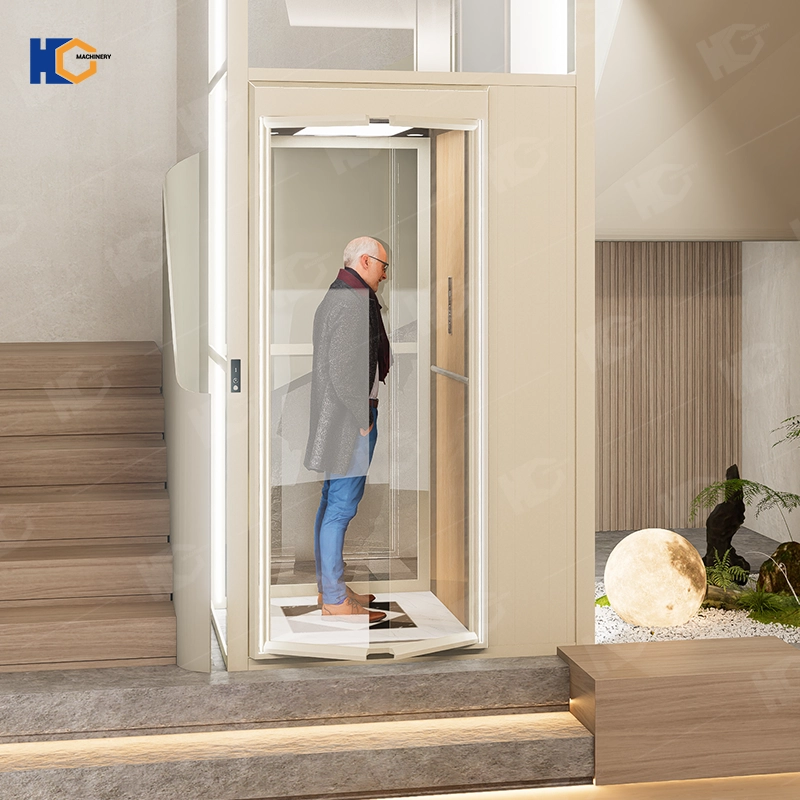1. What is a Capsule Lift?
A Capsule Lift is a modern, compact home elevator known for its sleek design, stylish appearance, and high efficiency. Compared to traditional elevators, it occupies less space and offers flexible installation options, making it suitable for duplex apartments, villas, lofts, and small commercial spaces.
The Capsule Lift features a modular design, often equipped with a transparent or semi-transparent cabin to provide a panoramic view and enhance the sense of space. It employs various drive systems, including screw drive, hydraulic drive, or traction drive, ensuring smooth and safe operation.
The two-person Capsule Lift is specifically designed for 1-2 people, with a load capacity typically ranging between 200-300kg, making it ideal for residential or small office use.
159347.webp)
2. Specifications of a Two-Person Capsule Lift
(1) Basic Parameters
Load Capacity: 200-300kg (2 persons + personal items)
Cabin Dimensions (Internal):
Width: 800-1000mm
Depth: 800-1000mm
Height: 2000-2200mm
Shaft Dimensions (Minimum Installation Space):
Width: 1100-1300mm
Depth: 1100-1300mm
Height: Customized based on floor height (usually 2.5m or more)
Speed: 0.15-0.3m/s (standard for home use, ensuring smooth and comfortable operation)
Number of Stops: 2-4 floors (customizable for more)
Door Type: Automatic side-opening or manual sliding door (optional)
(2) Materials & Design
Cabin Material: Tempered glass (panoramic design), stainless steel frame, acrylic panels
Drive System: Screw drive (low noise, maintenance-free), hydraulic drive (high load capacity), or traction drive (energy-efficient)
Safety Features: Emergency braking, power-failure descent, anti-pinch sensors, overload alarm
964209.webp)
3. Pricing for a Two-Person Capsule Lift
The price of a Capsule Lift depends on materials, drive system, brand, and customization requirements. Below are market reference prices:
| Configuration | Price Range ($) |
|---|---|
| Basic Model (Tempered Glass + Screw Drive) | 12,000−18,000 |
| Mid-Range Model (Panoramic Glass + Hydraulic Drive) | 18,000−25,000 |
| Premium Custom Model (Smart Control + Luxury Interior) | 25,000−35,000 |
Note: Prices include equipment and installation but exclude civil engineering modifications (e.g., shaft construction).
4. How to Install a Capsule Lift?
The installation process for a Capsule Lift includes the following steps:
(1) Pre-Installation Preparation
Space Measurement: Ensure the shaft dimensions meet requirements (width, depth, height).
Structural Assessment: Verify floor load-bearing capacity (≥300kg/m²).
Power Supply: Standard 220V power supply with a dedicated circuit.
(2) Installation Steps
Shaft Construction (if needed, using steel or concrete).
Track Installation (ensure vertical alignment with <5mm deviation).
Drive System Installation (screw/hydraulic unit fixed at the top or bottom).
Cabin Assembly (glass or metal panel assembly).
Electrical Wiring (connect control panel, safety sensors).
Testing & Commissioning (no-load/load operation, emergency brake test).
(3) Inspection Standards
Smooth operation with no abnormal noise.
Responsive door sensors and anti-pinch function.
Functional emergency stop button.
618916.webp)
5. Maintenance of a Capsule Lift
To ensure long-term safety, regular maintenance is required:
(1) Routine Maintenance
Clean cabin glass/metal surfaces.
Check tracks for obstructions.
Test emergency call function.
(2) Professional Maintenance (1-2 times/year)
Lubricate the drive system (screw or chain).
Inspect electrical components (cables, sensors).
Calibrate the control system (speed, leveling accuracy).
Maintenance Cost: Approximately 200−200−500/year (varies by usage frequency).
6. Design and Manufacturing Process of a Capsule Lift
(1) Design Phase
Requirement Analysis: Load capacity, number of floors, door type.
3D Modeling: Custom cabin design and shaft adaptation.
Structural Simulation: Ensure load-bearing and safety compliance.
(2) Manufacturing Phase
Frame Construction: Stainless steel or aluminum alloy structure.
Glass/Panel Cutting: Tempered and anti-shatter treatment.
Drive System Assembly: Screw/hydraulic unit testing.
Control System Integration: PLC or microcomputer control.
(3) Quality Standards
EN 81-41 (Home Elevator Safety Standards).
CE Certification (EU Market Compliance).
Load Testing (1.5x rated capacity).
778401.webp)
7. Professional Advice for Bulk Buyers
If you are a developer, hotel owner, or distributor, bulk purchasing can reduce costs and ensure supply stability. Here are some recommendations:
(1) Choose a Reliable Supplier
Verify factory certifications (ISO 9001).
Request a sample for testing.
(2) Customization Options
Brand logo integration.
Bulk discounts (5%-10% off for 10+ units).
(3) After-Sales Support
Ensure local maintenance teams are available.
Sign long-term service agreements.
8. Recommended Premium Supplier: JNHC Lift
Among many Capsule Lift manufacturers, JNHC Lift stands out for the following advantages:
✅ High-Quality Manufacturing: German technology, strict quality control.
✅ Customization Flexibility: Multiple sizes, colors, and drive options.
✅ Global Service: Exported to 50+ countries, fast after-sales response.
✅ Cost-Effective: Exclusive discounts for bulk purchases.
Contact JNHC Lift for a free consultation and quote!
Conclusion
The Capsule Lift is an ideal vertical transportation solution for modern homes and commercial spaces. The two-person model offers compact design, easy installation, and a perfect blend of aesthetics and functionality. Choosing a professional manufacturer like JNHC Lift ensures safety, reliability, and long-term satisfaction. For further inquiries, feel free to reach out to elevator experts!
551.webp)
344.webp)
